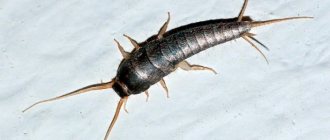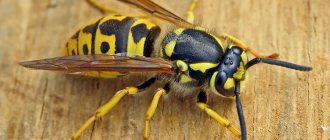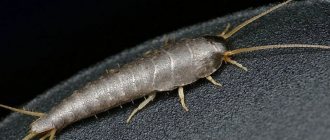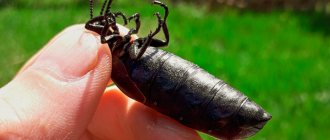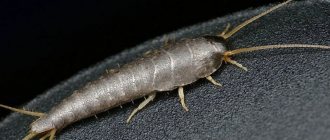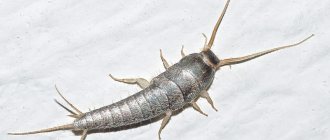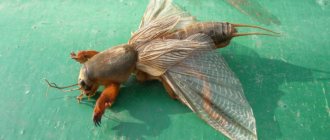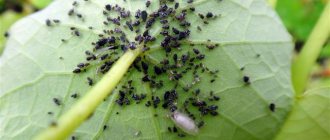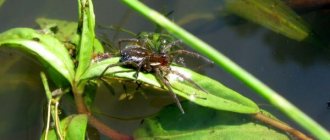The common silverfish (sugar silverfish, lat. lepisma saccharina) lived on earth three hundred million years ago. They belong to the phylum Arthropods and the order Bristletails. Now these insects are often found in apartments. They get into the house from products containing starch and polysaccharides. They do not pose any harm to human health.
Silverfish: photo
Silverfish living in the house.
Where do silverfish live at home?
For the first time, insects come across the eye most often completely by accident. To accurately assess the situation with parasites, it is necessary to examine certain areas of the apartment. To do this, it is important to know where silverfish live at home. Most often this is:
- The space under the sink, toilet, washing machine.
- Places where water and sewer pipes pass.
- Under rugs in the bathroom and toilet.
- In the laundry basket if it is in the bathroom.
- Under and in the kitchen sink.
- In the drawer under the sink, where most often there is also a trash can.
- In drawers where food is stored.
- Under and behind the refrigerator.
For a comfortable existence, silverfish need:
- Available food sources.
- Humidity.
- Warm.
The combination of these three factors determines exactly where the beetle will live.
If suitable conditions exist not only in the bathroom and kitchen, then the insect can penetrate onto the balcony, into the living room, and into the pantry. The main reason why silverfish appear is either an accident, when you yourself brought insects along with new things or products into the house, or unsanitary conditions in public areas of the house or among neighbors, when parasites come through ventilation or along walls from other infected rooms.
Description of the pest
Name: Common or sugar silverfish Lat.:
Lepisma saccharinaClass: Insects - Insecta Order: Bristletails - Zygentoma Family: Silverfish - Lepismatidae
| Habitats: | wet parts of the house |
| Dangerous for: | products, paper, interior items |
| Means of destruction: | traps, unpleasant odors, chemicals |
There are about 190 species of silverfish. About 10 species live in temperate latitudes. The insect resembles a flycatcher, although the latter have longer legs. Many scientists believe that the homeland of insects is the tropics.
Ideal conditions for reproduction are considered to be a humidity of at least 75% and a temperature of 21 to 26 degrees Celsius. In front of the silverfish there is a pair of long whiskers. The posterior part is characterized by three tail filaments. Insects don't have wings. They are nocturnal.
Pests are afraid of bright lighting. When exposed to light, they seek shelter. They move in quick dashes, sometimes making short pauses. When the temperature drops below 5 degrees Celsius, they go into suspended animation. At temperatures of 10 degrees below zero, larvae and adults die.
Ancient origins of silverfish
These insects lived in ancient times, their remains were discovered in the Carboniferous period, that is, they were found 400 million years ago.
Silverfish are ancient insects.
Silverfish and their relatives may be the ancestors of modern insects. Ancient insects crawled along the bottom of reservoirs and then came out onto land; most likely, they looked like silverfish. These small insects quickly ran along the banks and fed on algae. Over time, they populated wet lowlands and forests, and insects mastered the land.
If you find an error, please select a piece of text and press Ctrl+Enter.
Life cycle
The insect's lifespan is about 3 years.
Development speed
One generation develops over several months in nature. As temperatures rise over a couple of months, individuals appear that can develop and mate.
Starting a family
To increase the population, about 10 representatives are needed. Together they can create a family and lay eggs. The eggs are white. They have an oval shape. The size does not exceed 1 mm.
Formation of eggs
As they form, the eggs become darker with a brown tint. The duration of egg maturation at a temperature of 20 degrees Celsius is about 40 days, and at 30 degrees Celsius - 25 days.
Appearance of larvae
The second stage of development is characterized by the absence of scales. They appear after the end of the second molt. Molting occurs 5 times in larvae and throughout life in adults.
Reproduction
Common silverfish have pronounced sexual dimorphism, in which the difference between individuals lies in the structure of the reproductive system of the representatives. As such, there is no mating process between individuals of different sexes. Males leave their spermatophores, which are then found by females and fertilized on their own. After direct fertilization, egg laying occurs. Typically, about 50 eggs appear, but the number can vary from 20 to 70. It is determined by the state of the environment. The more humid the climate and warmer temperatures, the more offspring are born. At a temperature of 30 degrees, incubation lasts about 25 days. The eggs are no more than one millimeter in size and brown in color. White larvae without reproductive system and scales emerge from them. The state of an adult larva is reached after 5 molts.
The lifespan of common silverfish can be more than 4 years.
Types of silverfish
Common silverfish.
The main varieties include:
- ordinary or sugar - may have a gray, whitish, yellowish or light green tint. Females are not fertile. The maximum clutch during life is 10 eggs;
- home - size up to 12 mm. The color is brown or greenish. Laying up to 40 eggs. Usually settles in the kitchen;
- comb - an inhabitant of the Crimea;
- ant - settles in an anthill, feeding on the sweet drops of ants.
Appearance
The common silverfish is a very small insect with a body length from 0.8 millimeters to 1.9 centimeters . The body itself is flat and tapering at the end. The color is predominantly silver-gray. However, this color appears after the third molt. Thanks to its scaly cover, it received the name “silverfish”. The insect has a tail with three threads, two of them located on the sides and one in the middle. There are small antennae on the head.
The common silverfish does not have wings, but is endowed with only a body and three pairs of legs.
Diet
Silverfish feed on foods containing proteins, starch, and sugar. The food system is able to digest cellulose, which is the basis of paper. The pest is capable of eating wallpaper, starched fabric, and plant remains.
Silverfish are not capable of biting humans or animals.
Silverfish close-up.
They don't try to get onto the pillow or bed. Insects do not carry bacteria or their pathogens. They cause damage:
- food - they eat household supplies and leave scales with excrement;
- paper products - they can chew through books and photographs, which can lead to the destruction of important information;
- interior and household items - are saturated with starch, which is found in wallpaper paste or in the composition of laundry treatment substances. May damage fabric, wallpaper, paintings, souvenirs.
Habitat
Common silverfish choose moist and dark places as their habitat. In nature, they live mainly under fallen leaves, snags or stones. Moist and warm places are chosen on the territory of houses, as a rule, they settle in bathrooms. Due to the structure of their body, they cannot rise above the second tier, so they most often live on the ground or on the floor. Common silverfish will not survive in dry, bright areas.
The activity of these species occurs at night, and they spend daytime in the dark. There is an assumption that the genus of silverfish comes straight from the tropics, since they have the best conditions for existence there. Also, common silverfish are extremely fast.
Reasons for the appearance of silverfish
High humidity is the only cause of pest invasion. They enter the room from:
- ventilation pipe - this is how most of all insects get in;
- cracks, cracks, windows and doors that are not tightly closed - the miniature size facilitates unnoticeable penetration;
- foreign objects - food, boxes from the basement, books, fabrics.
Silverfish in the house.
Nutrition
As a habitat, common silverfish choose products of plant origin, which contain a high content of starch and polysaccharide. Their diet includes such types of products as sugar, glue, flour, paper, starched fabrics. Common silverfish that live in forests feed mainly on plants, which also contain starch and polysaccharides.
Fighting methods
Some tips for fighting:
- dry the premises, since dryness and heat do not make it possible to survive, humidity should be no more than 30%;
- Using a solution of water with cloves, citrus, and lavender will help. Spray from a spray bottle once every 7 days;
- chemicals used include boric acid, pyrethrin, bleach, and copper sulfate;
- set traps in the form of a glass jar, wet paper, mechanical devices to catch cockroaches; leftover food is suitable for bait.
How to get rid of silverfish?
In most cases, people turn to a special service to eliminate such insects. In fact, you can purchase the appropriate chemical . Such preparations are quite effective and inexpensive, but it is necessary to carry out the processing carefully, because the substances contained in the composition are toxic, which means they can harm human health.
The following is suitable for disinfecting an apartment:
- copper sulfate;
- aerosols, the action of which is aimed at destroying various insects;
- chlorine-based bath cleaners.
To avoid the appearance of silverfish, you should take care of the high-quality functioning of the heating and ventilation systems. If the indoor air is relatively dry, the likelihood of insects appearing will be minimized. You can also additionally install an electric heated towel rail and modern ventilation, which will help maintain optimal temperature and humidity conditions in the bathroom even if the hot water supply is interrupted.
To get rid of silverfish in the bathroom, only proven means and methods .
- First, you need to remove furniture, interior items, and trash from the premises. This will allow you to efficiently process all hard-to-reach places.
- It is imperative to carry out a general cleaning of the bathroom, during which all items should be treated with chlorine-based products.
- After the room has dried, you need to wipe the surfaces with a solution of copper sulfate. To dry all corners, you can use a fan heater or portable fireplace.
- Aerosol preparations will be used against woodlice and silverfish. With their help, the bathroom is sprayed and closed for an hour. Weak plant-based solutions are not suitable, because they will not be effective enough. In order for such a treatment to help get rid of silverfish and other insects forever, it is repeated after a couple of days. After this, the room is thoroughly ventilated.
- You can use a simple composition based on boric acid powder and chalk. The ingredients are taken in a ratio of 1:4. This substance is sprinkled on corners and other hard-to-reach areas. After a week, the room is cleaned of powder and dead insects. Repeated treatment is carried out, leaving the mixture in the room for 5–10 days.
To get rid of silverfish, simple traps . So, a glass jar is wrapped with paper, window tape or insulating tape. Place a small slice of apple inside. The finished trap is placed in the bath overnight. In the morning you will find insects there, because silverfish crawl into the container and cannot get out of there.
If desired, you can make a wet trap. To do this, leave the soaked newspaper on the bathroom floor. By morning there will be a lot of insects here, because they prefer damp places. There is no need to unfold the newspaper. It should be carefully removed from the apartment and then burned.
Experts recommend getting rid of insects mainly using folk remedies , because they will help avoid the effects of toxic substances on the human body. If such recipes are ineffective, you should use chemicals. It is important to wear a respirator, safety glasses and gloves. Also, all residents and pets should be removed from the apartment during treatment.
